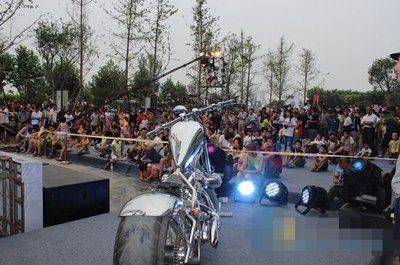
Common Problems in Motorcycle Modification and Practical Solutions
CustomStoreMCBiker
As motorcycle culture thrives around the world, more and more riders are choosing to modify their bikes to express individuality, improve performance, or showcase their club identity. Whether it’s street customization, retro styles, or club-oriented builds, every modification reflects the owner's unique taste and mechanical understanding. However, motorcycle modification is not without challenges. Poorly executed changes can affect riding experience and even compromise safety.
This article outlines common problems in motorcycle customization and offers practical advice to help riders make smarter, safer decisions.
1. Illegal Modifications and Compliance Issues
Common Issue: Many new riders are unaware of local laws and modify their bikes freely—changing exhaust pipes, removing factory lighting, or altering the bike’s structure—leading to failed inspections or fines.
Solutions:
-
Research Local Laws: Regulations vary by country or state. Always check local transportation laws before making any changes, especially related to exhaust noise, lighting brightness, and frame modifications.
-
Use Certified Parts: Choose components with DOT, E-mark, or other relevant certifications. This ensures your bike remains road-legal and safe.
-
Avoid Altering Registration Details: Modifications that change the VIN, engine number, displacement, or major body parts should be reported to authorities or avoided unless properly approved.
2. Power Loss After Exhaust Modification
Common Issue: Replacing a stock exhaust with a high-performance system sometimes leads to reduced power or sluggish throttle response.
Solutions:
-
Tune the ECU: A free-flow exhaust affects the air-fuel ratio. Reprogramming the ECU ensures the fuel injection and ignition timing match the new airflow.
-
Upgrade the Air Filter: A high-performance air filter helps balance intake and exhaust flow, optimizing combustion.
-
Use Model-Specific Exhausts: Not all racing exhausts suit every bike. Choose systems designed for your specific model to avoid performance loss.
3. Poor Handling After Tire or Rim Changes
Common Issue: Riders often replace tires or rims for a more aggressive look, only to find handling and stability compromised.
Solutions:
-
Stick to Manufacturer Specs: Tire width, aspect ratio, and diameter are carefully chosen by engineers. Deviate only within safe tolerances.
-
Prioritize Performance: While appearance matters, grip, braking distance, and wet weather performance are more important for safety.
-
Adjust Suspension Accordingly: Bigger tires or rims alter the suspension load. You may need to fine-tune or upgrade your suspension system.
4. Electrical Failures Due to DIY Wiring
Common Issue: After installing custom lights, speakers, or electronic systems, bikes often experience short circuits or power failures.
Solutions:
-
Use Quality Wires and Connectors: Avoid cheap, low-grade materials. Use heat-shrink tubing, sealed connectors, and appropriate fuses.
-
Install Relays and Fuses: High-wattage accessories require relays and dedicated fuses to prevent overloading circuits.
-
Create a Wiring Diagram: Document all changes to make future troubleshooting easier.
5. Decorative Parts Compromising Functionality
Common Issue: Some riders install flashy mirrors, bars, or lights without considering practical usage, compromising safety.
Solutions:
-
Function Over Form: Custom mirrors must still offer a clear rear view. Poor visibility is a serious hazard.
-
Choose Ergonomic Parts: Seats and handlebars affect long-ride comfort. Prioritize ergonomic designs over aesthetics.
-
Ensure Secure Installation: All accessories must be firmly mounted. Loose parts can fall off and cause accidents.
6. Ignoring Brakes and Suspension During Performance Upgrades
Common Issue: Riders upgrade their engines or exhausts but neglect brakes and suspension, resulting in unsafe handling at high speeds.
Solutions:
-
Upgrade Braking Components: Better acceleration demands better stopping power. Upgrade brake pads, calipers, and fluid as needed.
-
Improve Suspension System: High-performance suspension improves ride comfort, cornering, and overall control.
-
Maintain Balance: Adjust front and rear suspension for even ride height and stability during acceleration or braking.
7. Lack of Maintenance Awareness
Common Issue: After modifications are completed, some riders neglect regular checks, leading to loose parts, leaks, or breakdowns.
Solutions:
-
Routine Maintenance Checks: Monthly inspections for bolts, wiring wear, and fluid levels help catch problems early.
-
Keep a Modification Log: Record parts used, installation dates, and expected service intervals to plan maintenance effectively.
-
Consult Professionals: Have a mechanic inspect critical systems like engine tuning, brakes, and electricals every six months.
Conclusion: Customization is Art—with Responsibility
Motorcycle modification is an art that reflects personality, performance needs, and club pride. But every modification brings challenges related to safety, legality, and engineering.
Always research thoroughly, plan carefully, and when in doubt, consult experienced professionals. This approach ensures your bike not only looks great but also performs reliably and remains street-legal.
There is no finish line in the world of motorcycle customization—only continuous learning and upgrading. May every rider find joy and confidence in the journey of riding and customizing!
Looking for custom motorcycle patches, gear, or accessories? Visit our store at
👉 mcbikercustomstore.us
We offer professional one-stop customization for motorcycle clubs worldwide—make your ride stand out from the rest.